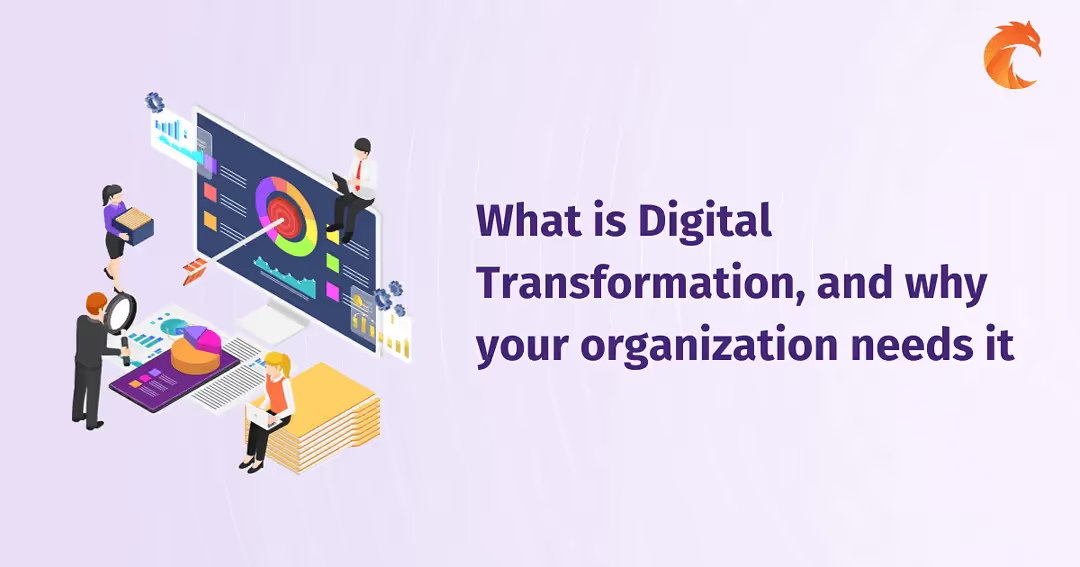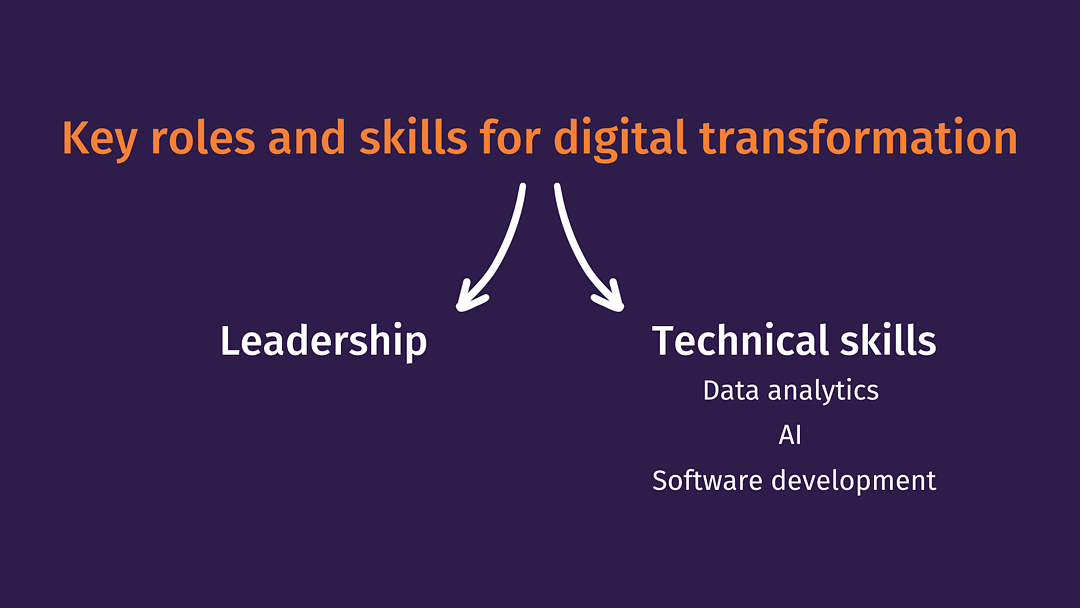What is Digital Transformation, and why your organization needs it


In the era of rapid technological advancements, embracing digital transformation is no longer a luxury but a necessity for organizations striving to stay competitive and thrive.
By integrating digital technologies into every facet of their operations, businesses can unlock new opportunities, streamline processes, and better serve their customers. Are you ready to explore the world of digital transformation and discover the strategies and innovations that are shaping the future of business?
Key Takeaways
- Digital Transformation involves integrating digital technologies to optimize business processes and remain competitive.
- It requires a clear vision, appropriate technology selection, and an effective change management plan.
- AI/ML, mobile techs & personalized user experiences are emerging trends in Digital Transformation that require businesses to innovate for success.
The Essence of Digital Transformation

Digital transformation refers to the integration of digital technologies into all aspects of a business, reshaping how companies function and provide customer value. It promotes an innovative and flexible culture, allowing companies to adjust to market shifts and maintain competitiveness.
The mid-2010s saw digital transformation emerge as a key strategic initiative driven by the rise of mobile communications, cloud computing, data analytics, and other advanced digital tools. Successful digital transformations necessitate:
- A clear strategy
- Appropriate digital resources
- The ability to overcome obstacles like resistance to change, outdated systems, and cybersecurity threats.
Defining Digital Transformation
Digital transformation can be defined as the use of technology to advance business models, streamline processes, and adjust to changing market dynamics. It is important to understand that digital transformation technologies, such as:
- Cloud computing
- Artificial intelligence and Machine Learning
- IoT
are often combined rather than implemented independently.
Innovation in the current world depends on combining one digital technology with another. Furthermore, it requires strategically designing various processes to achieve desired business objectives - the main goal of business digital transformations.
The role of Digital Transformation in organization
Digital transformation is vital for companies to maintain competitiveness, enhance customer experiences, and stimulate business expansion. By leveraging the right technology and digital solutions, businesses can significantly enhance their operations and the way customers interact with them.
During COVID-19, the importance of digital transformation intensified as companies had to rapidly adjust to disruptions in supply chains, time-to-market constraints, and changing customer needs. Many business leaders realized back then, that it's not an optional process anymore, but rather competitive advantage and a necessity in today's worlds.
Key Components of a Successful Digital Transformation Strategy

For a successful digital transformation, companies must concentrate on three main elements: a clear vision and goals, suitable technology choice, and an all-encompassing change management strategy. Numerous digital transformation frameworks, such as MIT Sloan’s “The New Elements of Digital Transformation” and Prophet’s “Six Stages of Digital Transformation,” emphasize these common themes. By following a well-organised framework, companies can generate progressive value and successfully manage the complexities of digital transformation.
Vision and Goals
Setting a clear vision and goals for digital transformation is fundamental in coordinating the efforts of the company and its stakeholders towards a shared objective. Organizations can achieve this by:
- Defining the business problem or opportunity
- Collecting and analyzing data
- Assessing the current digital state
- Creating a digital transformation roadmap or strategy
By following these steps, organizations can ensure that their digital transformation goals are in line with their overall corporate objectives and strategic vision.
This alignment is vital for spurring innovation and maximising the advantages of digital transformation.
Technology Selection
Selecting suitable technologies is critical for driving digital transformation, as it allows companies to utilise the potential of innovations such as cloud computing, AI, and data analytics. When selecting technology, organizations should consider factors such as alignment with organizational goals, impact on performance, adaptability and scalability, ease of use, cost-effectiveness, integration capabilities, security and data privacy, and vendor reputation and support.
With suitable technology in place, companies can fully exploit the potential of digital transformation and enjoy the advantages of improved efficiency, better customer experiences, and heightened competitiveness. If you're looking for help in technology selection that will be aligned with your business strategy, you can contact companies with experience in this field, such as Curiosum.
Change Management
Change management takes on a pivotal role in guaranteeing the successful uptake of digital transformation initiatives by tackling cultural and organisational hurdles.
Effective change management strategies include:
- Fostering open communication and transparency
- Offering training and support
- Including employees in the process
- Addressing worries and apprehensions
- Beginning with small, achievable changes
Overcoming resistance to change and endorsing an innovative culture is a key for companies looking to successfully manage the challenges and amplify the benefits of digital transformation.
Real-World Examples of Digital Transformation

Examples of digital transformation from industry leaders and small-medium enterprises illustrate the advantages of adopting technology and innovation for business success. From utilizing artificial intelligence and machine learning to enhance customer experiences to employing mobile technologies to optimize customer service, these real-world examples demonstrate the transformative power of digital technologies.
Industry Leaders
Companies such as Amazon, Toyota, and Domino’s Pizza have effectively executed digital transformation strategies to improve customer experiences and stimulate growth. Here is a small summary of digital disruption happening in these companies.
- Amazon uses AI and cloud computing to optimize operations, evidenced by AWS's services for AI development, machine learning applications in its fulfillment centers, and AI-driven innovations like Alexa and Amazon Go stores. This approach has revolutionized logistics, customer service, and business growth, with over 100,000 customers utilizing AWS for AI and machine learning initiatives across various industries.
- Toyota's digital transformation integrates innovative teams and technologies, enhancing operational agility and efficiency. This approach includes AI and robotic process automation, underpinning an enterprise-wide digitization effort. Toyota's significant investment in ICT and Information Digital Systems underscores its commitment to leveraging digital technologies for business innovation and improved customer experiences.
- Domino's Pizza's digital transformation centers on enhancing customer experience and involves data analytics and upgraded technology infrastructure. This includes a digital platform for customer orders and the use of AI and sensor technology in the DOM Pizza Checker to ensure pizza quality, demonstrating the company's commitment to digital innovation for improved customer satisfaction.
Small and Medium Enterprises
Small and medium enterprises can likewise gain from digital transformation by utilising technology to enhance operational efficiency and investigate new market opportunities. Enabling innovation through digital platforms in SME allows them to:
- Become more agile
- Integrate processes
- Reduce operation costs
- Generate productivity gains
By adopting digital transformation, small and medium enterprises can equalise the competitive landscape and vie with larger industry competitors.
Overcoming Challenges in Digital Transformation
Overcoming challenges in digital transformation involves tackling resistance to change, managing legacy systems, and ensuring strong cybersecurity measures.
By comprehending and addressing these challenges, companies can successfully manoeuvre the complexities of digital transformation and maximise its positive influence on their business.
Resistance to Change
Resistance to change is a common problem in digital transformation initiatives, with roughly 70% of such initiatives failing because of the employees’ and management’s unwillingness to adjust to the changes. This resistance often stems from a lack of understanding or fear of the unknown. Employees may worry about job security, the need to acquire new skills, or the loss of familiar routines. Similarly, management may have concerns about the costs, risks, or disruption associated with digital transformation.
To effectively manage resistance to change during digital transformation, organizations should invest in open communication, offer training and support, and include employees in the process. Open communication can dispel fears and misconceptions, while training and support can equip employees with the skills and confidence they need to embrace new technologies. Including employees in the process can ensure their buy-in and commitment, making them active participants rather than passive recipients of change.
Don't neglect this step, as it surely have impact on transformation initiative success.
Legacy Systems
Outdated systems can impede digital transformation efforts, as they are founded on obsolete technologies and may present difficulties in adapting to changes. Modernizing or replacing legacy systems is essential for successful digital transformation, as it:
- Boosts efficiency
- Enhances security
- Provides scalability and flexibility
- Facilitates integration with new technologies
By addressing the challenges posed by legacy technology, organizations can unlock the full potential of digital transformation and drive business growth. As a dital consulting company, we had a chance to observe significance of this step numerous times - it's crucial to understand its impact on the whole process.
Cybersecurity
Cybersecurity is a significant concern in digital transformation, as companies must shield their digital assets and customer data from potential threats. By implementing robust cybersecurity measures, organizations can:
- Safeguard their digital systems and infrastructure
- Confidently adopt new technologies and digitize their operations
- Minimize the risk of cyberattacks and data breaches
- Ensure a secure and successful digital transformation.
Essential Roles and Skills for Digital Transformation

Key roles and skills for digital transformation consist of robust leadership and sought-after technical skills such as data analytics, AI, and software development. These roles and skills are crucial for implementing and managing digital initiatives, driving innovation, and ensuring the success of digital transformation efforts.
Leadership Roles
Leadership roles such as CIOs (Chief Information Officer), CTOs (Chief Technology Officer) and CDOs (Chief Digital Officer) take on a critical role in propelling digital transformation by:
- Coordinating technology adoption
- Nurturing a culture of innovation
- Strategically planning, developing, and coordinating efforts
- Creating the vision
- Propelling the transformation of the organization’s data and technology strategy
C-level executives collaborate in a digital transformation journey to achieve these goals. Leadership is mandatory in driving change and promoting collaboration between teams.
In-Demand Tech Skills
Sought-after skills for digital transformation include:
- Data Analytics
- AI and ML
- Web and mobile development
- UI/UX design
These tech competencies are critical for businesses aiming to innovate or digitalize their operations. If your organization lacks these skills and faces challenges in implementing an effective transformation process, consider partnering with experts in these areas, like Curiosum. They can ensure that experienced professionals guide your digital transformation journey while you don't have to hire them in-house.
Measuring the Success of Digital Transformation
Assessing the success of digital transformation involves monitoring key performance indicators (KPIs) and determining return on investment (ROI). By observing these metrics, companies can evaluate the efficiency of their digital transformation initiatives, pinpoint areas for enhancement, and confirm that their efforts are in line with their comprehensive business objectives.
Key Performance Indicators (KPIs)
KPIs help organizations monitor the progress of their digital transformation initiatives and identify areas for improvement. Common KPIs in digital transformation include:
- Employee productivity - measures how effectively employees adapt to new digital tools and processes
- Adoption and performance metrics - tracks how quickly and effectively new technologies are being integrated and utilized within the organization
- Usage metrics - provides insights into how frequently and in what ways digital tools and platforms are being used
- Cost and investments - evaluates the financial aspects, including expenses and investments, related to digital transformation projects
- User lifetime value - assesses the long-term value of customers or users in the context of the new digital environment
- Customer experience - measures how digital transformation impacts customer satisfaction and engagement
- ROI - calculates the financial return on digital transformation investments, helping to assess their overall effectiveness and value
ROI Calculation
Calculating ROI on digital transformation helps organizations assess the financial impact of their efforts and justify investments in technology and innovation. ROI calculation involves demonstrating a convincing financial return on investment, taking into account factors such as:
- Cost reduction of operations
- Increased productivity
- Business expansion
- Data security
- Revenue growth
- Customer satisfaction growth
Measuring ROI is incredibly important. After all, a digital transformation is only effective when ROI is satisfying for the organization.
Emerging Trends in Digital Transformation
Emerging trends in digital transformation encompass AI and machine learning, mobile technologies, and personalized user experiences, which are sculpting the future of business and technology. As these trends continue to evolve, businesses must stay ahead of the curve and embrace new business models and innovations to remain competitive and deliver exceptional customer experiences.
AI and Machine Learning
AI and machine learning are revolutionizing digital transformation by empowering companies to automate processes, derive insights from data, and improve decision-making. From optimizing product timelines to analyzing and interpreting large volumes of data in real time, AI and machine learning are driving innovation and transforming the way businesses operate and interact with their customers.
Yet another huge step towards transformation initiative in this field are LLM's.
Mobile Technologies
For over ten years already, mobile tech has really changed the game by making sure we're all connected, no matter where we are. It's like having the internet, all our apps, and services right in our pocket, ready to go whenever we need them. This is very handy for staying in touch, working together, and making quick decisions. It's a big part of what's driving digital transformation today - we have these amazing tech advancements to thank for keeping us all linked up and moving forward in the digital world.
Personalized User Experiences
Personalized user experiences are growing in importance in digital transformation as companies aim to deliver customized products and services that satisfy individual customer requirements.
To achieve this, organizations can follow these steps:
- Conduct UX research to gain an understanding of user needs and behaviors.
- Create wireframes to visualize the user experience and gather feedback.
- Focus on experience optimization by continuously testing and refining the user interface and interactions.
These are just a couple of steps organizations can conduct to create experiences that meet the needs of their users and drive customer satisfaction.
Personalized user experiences not only enhance customer satisfaction but also drive innovation and business growth.
Summary
In conclusion, digital transformation is a vital process for organizations looking to stay competitive and grow in today’s rapidly evolving business landscape. By integrating digital technologies, setting clear goals, selecting the right tools, and addressing challenges, businesses can successfully navigate the complexities of digital transformation and maximize its benefits. By staying ahead of emerging trends and embracing innovations like AI, mobile technologies, and personalized user experiences, organizations can unlock new opportunities and deliver exceptional value to their customers. The time to embrace digital transformation is now - are you ready to seize the opportunity?
Ready to scale your business with the right tech partner?
Related posts
Dive deeper into this topic with these related posts
You might also like
Discover more content from this category
Outsourcing software development is popular but not easy. What might stop it from being successful?
The PropTech industry, a blend of property and technology, represents a rapidly growing sector where innovation is reshaping how you buy, sell, and manage real estate.
As the software development landscape evolves, no-code and AI-assisted development tools are gaining significant attention.







